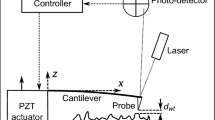Abstract
Utilising arrays of cantilevers has been identified as a method of increasing AFM sensitivity and throughput beyond the limitations of current non-contact AFM. In order to develop the technology, we investigate the change in eigenstates of arrays due to interactions that occur between cantilever tip and sample using a model of a base-coupled array of cantilevers with individual mass and stiffness properties influenced by a quadratic nonlinear force to represent tip–sample interactions. An analytical expression is developed for a coupled two-beam array utilising Multiple Scale Lindstedt–Poincare perturbation theory to assess how a selected parameter space alters the array dynamics. Experiments are carried out using a macroscale set-up to validate the developed model. We show that the model captures the eigenstates of the system with good qualitative accuracy and that the perturbation expansion performs well in both the weakly (far from surface) and strongly (near the pull-in point) nonlinear regimes. The results demonstrate that utilising changes in eigenstates due to force interactions could have significant benefits to non-contact AFM with regard to measurement sensitivity and speed.








Similar content being viewed by others
References
Abramovitch, D.Y., Andersson, S.B., Pao, L.Y., Schitter, G.: A tutorial on the mechanisms, dynamics, and control of atomic force microscopes. In: American Control Conference (2007)
Albrecht, T.R., Grutter, P., Horne, D., Rugar, D.: Frequency modulation detection using high-Q cantilevers microscope sensitivity for enhanced force. J. Appl. Phys. 69(2), 668–673 (1991)
Ando, T.: High-speed atomic force microscopy coming of age. Nanotechnology 23(6), 1–27 (2012)
Chakraborty, I., Balachandran, B.: Near-grazing dynamics of base excited cantilevers with nonlinear tip interactions. Nonlinear Dyn. 70(2), 1297–1310 (2012)
Dahleh, M., Bamieh, B., Napoli, M.: Optimal control of arrays of microcantilevers. IEEE Conf. Decis. Control 121, 2077–2082 (1999)
Dankowicz, H., Nordmark, A.B.: On the origin and bifurcations of stick-slip oscillations. Phys. D Nonlinear Phenom. 136, 280–302 (2000)
Dick, A.J., Balachandran, B., Mote, Jr. C.D.: Intrinsic localized modes in microresonator arrays and their relationship to nonlinear vibration modes. Nonlinear Dyn. 54(1–2), 13–29 (2008)
Gutschmidt, S., Gottlieb, O.: Nonlinear dynamic behavior of a microbeam array subject to parametric actuation at low, medium and large DC-voltages. Nonlinear Dyn. 67(1), 1–36 (2012)
Hagedorn, P., DasGupta, A.: Vibrations and Waves in Continuous Mechanical Systems. Wiley, Hoboken (2007)
Kimura, M., Hikihara, T.: Coupled cantilever array with tunable on-site nonlinearity and observation of localized oscillations. Phys. Lett. A 373(14), 1257–1260 (2009)
Lenczner, M., Smith, R.C.: A two-scale model for an array of AFM’s cantilever in the static case. Math. Comput. Model. 46(5–6), 776–805 (2007)
Lifshitz, R., Cross, M.: Response of parametrically driven nonlinear coupled oscillators with application to micromechanical and nanomechanical resonator arrays. Phys. Rev. B 67(13), 134302 (2003)
Napoli, M., Zhang, W., Turner, K.L., Bamieh, B.: Characterization of electrostatically coupled microcantilevers. J. Microelectrom. Syst. 14(2), 295–304 (2005)
Nayfeh, A.H.: Introduction to Perturbation Techniques. Wiley-VCH, Weinheim (2004)
Pakdemirli, M., Karahan, M.M.F., Boyac, H.: A new perturbation algorithm with better convergence properties: Multiple scales lindstedt poincare method. Math. Comput. Appl. 14(1), 31–44 (2009)
Spletzer, M., Raman, A., Sumali, H., Sullivan, J.P.: Highly sensitive mass detection and identification using vibration localization in coupled microcantilever arrays. Appl. Phys. Lett. 92(11), 824–833 (2008)
Spletzer, M., Raman, A., Wu, A.Q., Xu, X., Reifenberger, R.: Ultrasensitive mass sensing using mode localization in coupled microcantilevers. Appl. Phys. Lett. 88(25), 10–13 (2006)
Author information
Authors and Affiliations
Corresponding author
Appendices
Appendix 1
Expansion of the two-beam Eq. (14) prior to applying perturbation expansions.
with the following definitions
Appendix 2
Eigenvalues and eigenvectors for the first-order perturbation solution (20).
Appendix 3
Secular terms of the two-beam perturbation model (31) and (32).
Appendix 4
The following values are used for the single-beam and two-beam experiments.
Rights and permissions
About this article
Cite this article
Jackson, S., Gutschmidt, S., Roeser, D. et al. Development of a mathematical model and analytical solution of a coupled two-beam array with nonlinear tip forces for application to AFM. Nonlinear Dyn 87, 775–787 (2017). https://doi.org/10.1007/s11071-016-3076-7
Received:
Accepted:
Published:
Issue Date:
DOI: https://doi.org/10.1007/s11071-016-3076-7




